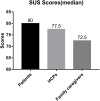Development of a Pulmonary Rehabilitation Patient Decision Aid for Patients with Chronic Obstructive Pulmonary Disease: Mixed Methods Study
- PMID: 37465820
- PMCID: PMC10350428
- DOI: 10.2147/COPD.S392191
Development of a Pulmonary Rehabilitation Patient Decision Aid for Patients with Chronic Obstructive Pulmonary Disease: Mixed Methods Study
Abstract
Background: Pulmonary rehabilitation is an important part of the management of chronic obstructive pulmonary disease (COPD), but the participation rate of pulmonary rehabilitation in COPD patients is low. Patient decision aids can facilitate patient participation in pulmonary rehabilitation decisions by providing information and incorporating patient values. The aim of this study was to develop a pulmonary rehabilitation decision aid for patients with COPD.
Objective: The aim of this study was to develop a WeChat-based pulmonary rehabilitation patient decision aid to help older patients with COPD participate in pulmonary rehabilitation decision-making.
Methods: We developed the decision aid in 3 stages: (1) a literature review was performed to determine the evidence for pulmonary rehabilitation options and outcomes for patients with COPD. (2) a semi-structured interview study was conducted to develop and iterate patient decision aids. (3) usability, acceptability and language expression testing in patients and healthcare professionals.
Results: A total of 16 randomized controlled studies were included in the literature review. Thirty-six participants received semi-structured interviews. The results of interview include four themes: key points of age-friendly design, content of the tool, presentation requirements of contents and study evidence of the tool and other views and suggestions. The resultant goals-of-care decision aid achieved good usability and acceptability. The frequency of language expression increased in both patients and healthcare professionals.
Conclusion: This study uses a systematic development process to develop the first pulmonary rehabilitation decision aid for patients with COPD. It has good usability, acceptability and increased communication between patients and healthcare professionals in the pulmonary rehabilitation decision-making process.
Trial registration: Chinese Clinical Trial Registry (ChiCTR): ChiCTR1900028563; http://apps.who.int/trialsearch/default.aspx.
Keywords: chronic obstructive pulmonary disease; patient decision aid; pulmonary rehabilitation; shared decision making.
© 2023 Jiang et al.
Conflict of interest statement
The authors report no conflicts of interest in this work.
Similar articles
-
Effectiveness of patient decision aid supported shared decision-making intervention in in-person and virtual hybrid pulmonary rehabilitation in older adults with chronic obstructive pulmonary disease: A pilot randomized controlled trial.J Telemed Telecare. 2024 Dec;30(10):1532-1542. doi: 10.1177/1357633X231156631. Epub 2023 Mar 15. J Telemed Telecare. 2024. PMID: 36919365 Clinical Trial.
-
A shared decision-making intervention for individuals living with chronic obstructive pulmonary disease who are considering the menu of pulmonary rehabilitation treatment options; a feasibility study.Chron Respir Dis. 2024 Jan-Dec;21:14799731241238428. doi: 10.1177/14799731241238428. Chron Respir Dis. 2024. PMID: 39254860 Free PMC article.
-
A shared decision-making intervention between health care professionals and individuals undergoing Pulmonary Rehabilitation: An iterative development process with qualitative methods.PLoS One. 2024 Aug 19;19(8):e0307689. doi: 10.1371/journal.pone.0307689. eCollection 2024. PLoS One. 2024. PMID: 39159209 Free PMC article.
-
Healthcare professionals' perceptions of pulmonary rehabilitation as a management strategy for patients with chronic obstructive pulmonary disease: a critical interpretive synthesis.Disabil Rehabil. 2022 Feb;44(4):520-535. doi: 10.1080/09638288.2020.1769745. Epub 2020 Jun 1. Disabil Rehabil. 2022. PMID: 32478588 Review.
-
Systematic review of shared decision-making interventions for people living with chronic respiratory diseases.BMJ Open. 2023 May 2;13(5):e069461. doi: 10.1136/bmjopen-2022-069461. BMJ Open. 2023. PMID: 37130669 Free PMC article.
Cited by
-
Positive Psychology Insights on the Effects of Spirituality on Shared Decision-Making in Patients with Chronic Heart Failure: The Chain-Mediated Effects of Benefit-Finding and Decision Self-Efficacy.Healthcare (Basel). 2025 May 19;13(10):1188. doi: 10.3390/healthcare13101188. Healthcare (Basel). 2025. PMID: 40428023 Free PMC article.
-
Experiences and needs of older patients with stroke in China involved in rehabilitation decision-making: a qualitative study.BMC Med Inform Decis Mak. 2024 Nov 6;24(1):330. doi: 10.1186/s12911-024-02735-5. BMC Med Inform Decis Mak. 2024. PMID: 39506728 Free PMC article.
-
Clinically important changes and adverse events with centre-based or home-based pulmonary rehabilitation in chronic respiratory disease: A systematic review and meta-analysis.Chron Respir Dis. 2024 Jan-Dec;21:14799731241277808. doi: 10.1177/14799731241277808. Chron Respir Dis. 2024. PMID: 39187265 Free PMC article.
References
Publication types
MeSH terms
LinkOut - more resources
Full Text Sources
Medical


